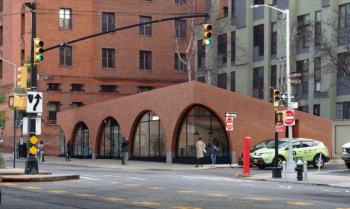
Rendering of 20 Old Fulton Street/Image Credit: NV Design Architecture
The new building features arched windows and entryway inspired by arches of buildings within the historic district. On February 11, 2020, the Landmarks Preservation Commission voted to approve, with modifications, a Certificate of Appropriateness to construct a new one-story commercial building on a vacant lot located at 20 Old Fulton Street. The lot is on the south side of Old Fulton Street, between Everit Street to the west and Elizabeth Place to the east. The lot has been vacant since the mid-1920s.
The new commercial building will be a one-story building that slopes up from the rear yard of the lot. The front of the building, which faces Old Fulton, is the building’s highest point and rises to a height of 16.5 feet. The lowest point of the building, in the rear, rises to a height of 10 feet and 2.5 inches. The building will be made out of red brick and will have four arched windows with an arched entryway in the center that span the building’s front façade. The two windows on each end of the front façade will wrap around the corners of the building. The windows and entryway are 18 feet wide and 10 feet tall and are decorated with recessed black metal. The bottom of the arches are decorated with cast concrete.
The proposed building possesses some of the prominent features seen throughout the Fulton Ferry Historic District. The historic district is characterized by buildings of different heights, types, and styles that reflect 19th Century commercial and industrial life and development in Brooklyn. Types of buildings in the district include warehouses and one to four story buildings. Vernacular Commercial Industrial, Federal Style, Greek Revival, and Italianate architectural styles can be seen throughout the district. Many of the buildings in the district are made from brick and have decorative details made from cast-iron, concrete, and stone.
The use of arches can be seen on buildings throughout the district. Tom Van den Bout of NV Design Architecture, the project’s architect, stated that the inspiration of the arches comes from the surrounding area. He stated that arches can be seen in the windows, entryways, and courtyard openings of the Empire Stores Warehouse on 53-83 Water Street, the Long Island Safe Depository Company building on 1 Front Street, and the Eagle Warehouse and Storage Company building on 28 Old Fulton Street. Van den Bout also stated that arches are also seen in the design of Brooklyn Bridge’s approach slab located nearby.
The Commissioners generally praised the design of the building. Vice Chair Frederick Bland stated that he admires how the two corner windows wrap around the edges of the building. He noted that the inclusion of the arches makes the building’s design look “kinetic and alive.” Commissioner Michael Devonshire agreed with Vice Chair Bland and stated that the building is appropriate and “fits in beautifully” with the district. Chair Sarah Carroll stated that the architect’s use of the arches gives the building a contemporary design. The only modification for the building’s design was that Chair Carroll and Vice Chair Bland believed the windows’ glass should be pushed back further into the building.
Landmarks voted to approve the project with the one modification because the building’s design uses materials found within the district, fits in with the other one and two-story buildings in the district, and relates well with the industrial character of the historic district and the Brooklyn Bridge.
By: May Vutrapongvatana (May is the CityLaw Fellow and New York Law School Graduate, Class of 2019)

